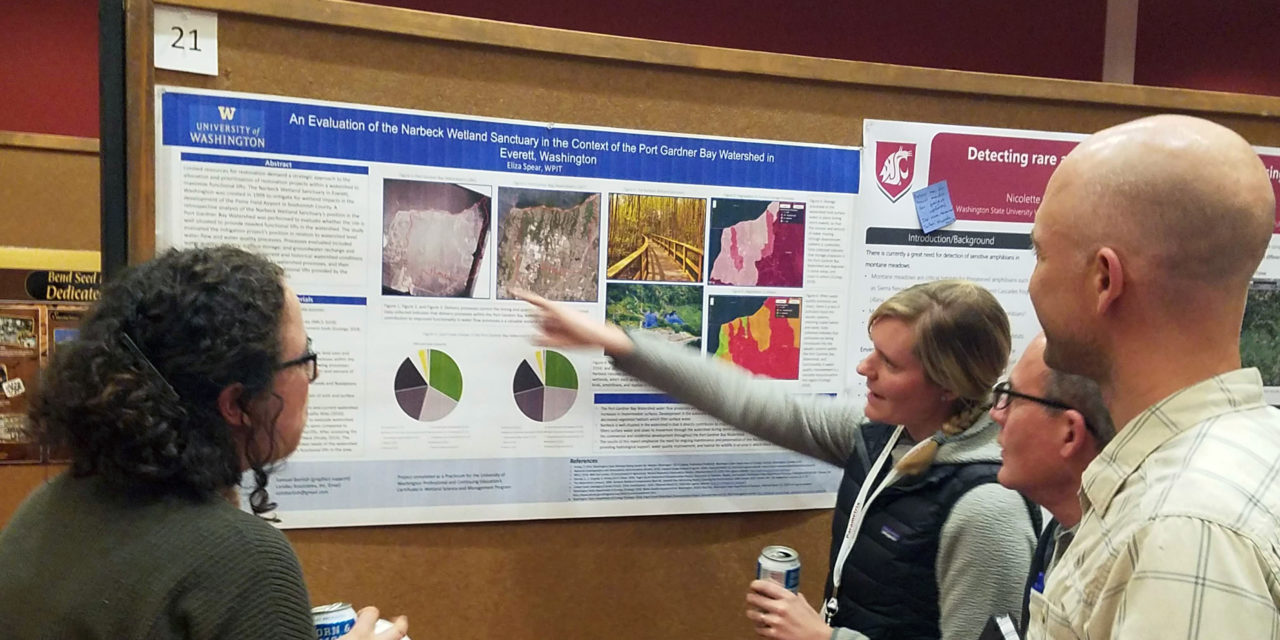Herrera scientists Christina Merten, Rob Zisette, Sue Wall, Shelby Petro, and Eliza Spear attended the joint regional conference for the pacific northwest chapters of the Society of Wetland Scientists and Society for Ecological Restoration in Spokane, WA on October 15-18, 2018. Herrera sponsored the morning coffee and snack break throughout the week. The conference was packed with interesting and inspirational talks of research and case studies. It was attended by many professionals in the field and we loved catching up with old friends and making new connections! Many thanks to the organizers from SWS and SER for a wonderful week in Spokane!
Starting off the week, Sue Wall, Senior Wetland Scientist, co-led a workshop with Dave Polster, Principal of Polster Environmental Services, discussing the Restoration of Contaminated and Drastically Disturbed Sites. Sue is based in Herrera’s Missoula, MT office and routinely works on mine reclamation sites, designing, implementing, and monitoring restoration efforts. More information about this workshop can be found here: https://restoration2018.org/programinfo/workshops/
On Tuesday evening, Eliza Spear, Natural Resources Scientist, participated in the poster session and shared An Analysis of the Narbeck Wetland Sanctuary in the Context of the Port Gardner Bay Watershed in Everett, Washington. This was a summary of her practicum project completed as part of the University of Washington’s Wetland Science and Management Certificate Program. Abstract: Limited resources for restoration demand a strategic approach to the allocation and prioritization of restoration projects within a watershed to maximize functional lifts. The Narbeck Wetland Sanctuary in Everett, Washington was created in 1999 to mitigate for wetland impacts in the development of the Paine Field Airport in Snohomish County. A retrospective analysis of the Narbeck Wetland Sanctuary’s position in the watershed was performed to evaluate whether the site is well situated to provide needed functional lifts in the watershed. The study evaluated the mitigation project’s position in relation to watershed level water-flow and water quality processes. Processes evaluated included water quality; delivery; surface storage; and groundwater recharge and discharge. The study compares current and historical watershed conditions to identify needs for improvement to watershed processes, and then compares these needs to the current functional lifts provided by the Narbeck Wetland Sanctuary mitigation area.
On Wednesday, Rob Zisette, Principle Aquatic Scientist (and floating wetland guru!) shared more of his knowledge on the benefits of floating wetlands in a presentation entitled Floating Wetlands for Bulkhead Impact Mitigation in Urban Lakes. Abstract: Bulkheads and other hardened shorelines in urban lakes can protect property from erosion, but the increased wave reflection caused by their presence erodes lake sediment, resulting in offshore sediment drift and a loss of emergent plant habitat. Sediment suspension and drift to deeper waters can impact lake water quality by increasing internal phosphorus loading. Loss of emergent vegetation can impact fish and wildlife, including endangered Chinook salmon. Green shoreline initiatives by Seattle and others promote removal of bulkheads to create natural beaches costing approximately $600 per linear foot. Floating wetlands are an effective alternative to bulkhead removal at about half the cost. This presentation will summarize bulkhead impacts, compare commercially-available floating wetland systems, describe their potential water quality and habitat benefits, and present alternative designs for the installation of floating wetlands along bulkheads in urban lakes.
